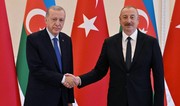The Japanese company TEPSCO has prepared and submitted to the government a concept document "Green Energy Zone in the occupied territories", Report informs, citing the Ministry of Energy.
Thus, within the concept's framework, energy supply options were assessed in terms of the population and economic development scenarios.
In addition, analyses were conducted on various green technologies to be applied, taking into account the area's energy potential. It is planned to prepare a Master Plan in the first half of 2022, which will include a more detailed analysis and proposals on the proposed scenario, defined within the framework of the concept.
As part of the task to create a "green energy zone", research is underway to ensure energy supply in order to study the solar, wind, biomass, thermal, geothermal, and another renewable energy potential in the liberated areas, to determine the coordinates of the areas, as well as to build wind and solar power plants and hydropower plants in reservoirs, lakes and small rivers using available resources. Thus, "green" energy projects are preferred in the construction work to be carried out in the liberated territories. According to preliminary estimates, the area's solar energy potential is 7,200 MW and wind energy potential is 2,000 MW.
Numerous expeditions were organized to Gubadli, Lachin, Kalbajar regions to study Small Hydroelectric Power Stations (HPS), where 45 stations with a total capacity of 241.3 MW, including 156 MW (41 units) HPPs were identified in the liberated areas (including areas where peacekeepers are stationed):
"It turned out that 34 stations were rendered useless by the occupiers as they left the territories. The water intake of most of the HPS-related stations, the coordinates of the generator building and the height differences for the calculation of water pressure have been determined accordingly."







